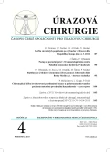-
Medical journals
- Career
Stabilisation of flail chest with rib plates Medin company - innovation of technics
Authors: František Vyhnánek 1; David Jirava 2; Martin Očadlík 2; Martin Šaber 3; Pavel Michal 3
Authors‘ workplace: Traumatologické centrum FNKV a 3. LF UK 1; Chirurgická klinika 3. LF UK a FNKV Praha 2; Medin, a. s., Nové Město na Moravě 3
Published in: Úraz chir. 23., 2015, č.4
Overview
Introduction:
Blunt chest trauma is associated with high risk of morbidity and mortality. Complications of chest trauma develop secondary to rib fractures as a consequence of significant pain and inadequate ventilation. In the therapy of flail chest is recommended a multi-disciplinary approach including conservative treatment (chest physiotherapy, analgesia, mechanical ventilation) and surgical intervention (stabilisation of the chest wall to use rib osteosynthesis). Early mechanical ventilation with internal pneumatic splinting is the basis of conservative treatment for flail chest in patients with respiratory insufficiency. The surgical stabilisation of a flail chest is recently accepted as valid method of treatment. It shortens the duration of mechanical ventilation, decreses long – term pain and thus reduces morbidity associated with prolonged ventilatory support. In addition, it decreases inability of a flail chest to heal due to malunion, non-union or progressive collapse of the flail segment. Rib fractures have been stabilized with external plates (Judet plates, anatomical plates) or intramedullary rib splints.Materials and methods:
Twenty nine consecutive injuried patients who underwent surgical stabilisation of flail chest at the Trauma Centre Faculty Hospital Královské Vinohrady between 2010-2014 were retrospectively evaluated. This included patient dermographics, chest injury extent, surgical stabilisation technics with Judet plates, and postoperative outcome. Surgical stabilisation of the chest wall was performed a interval from 1 hour to 9 days after injury. The surgical procedure was completed by chest tube placement. On the basis of the experience with rib osteosynthesis with Judet plates was performed innovation of rib plates in cooperation of developing department in Medin company. The goal of innovation were changes of technical parameters, which are compared with new plates of others companies.Results:
Surgical stabilisation was carried out using 3 to 8 plates for flail segment fixation ivolving 3 to 4 ribs. The duration of post-operative mechanical ventilation was 5 days on the average. It was longer (till 16 days) with associated injuries such as craniocereberal trauma, large pulmonary contusion, complicated pelvis fractures and bilateral flail chest. Tracheostomy was performed in 6 patients requiring prolonged mechanical ventilation. Two patients had superficial surgical site infection. No death was recorded in the follow-up period. Innovating plates were testing in laboratory model of the ribs and in cadaver with using of new instruments. New technics parameters including mass of plate, new fixating clips, locked screws and instruments are priorities of inno-vating plates.Conclusions:
Surgical stabilisation of the flail chest segment is considered an effective procedure in selected patients, leadi ng to improvement of respiratory function and shortens duration of ventilatory support. Innovating Judet plates are important step in extending of surgical treatment of the flail chest.Key words:
Flail chest, osteosynthesis, innovating plates.
Sources
1. BOTTLANG, M., WALLESER, S., NOLL, M. et al. Biomechanical rationale and evaluation of an implant system for rib fracture fixation. Eur J Trauma Emerg Surg. 2010, 36, 417–426.
2. FIZPATRICK, DC., DENARD, P.J., PHELAN, D. et al. Operative stabilization of flail chest injuries: review of literature and fixation options. Eur J Trauma Emerg Surg. 2010, 36, 427–433.
3. GIRSOWICZ, E., FALCOZ, P.E., SANTELMO,N. et al. Does surgical stabilization improve outcome in patient with isolated multiple distracted and painful non-flail rib fractures? Cardiovasc Thorac Surg. 2012, 14, 312–315.
4. GRANHED, HP., PAZOOKI, D. A feasibility study of 60 consecutive patiens operated for unstable thoracic cage. J Trauma Manag Outcomes. 2014, 8, 20.
5. KITKA, M. Poranění hrudníka. Zbierka Jána Bauera, 2014, 75.
6. LEINICKE, JA., ELMORE, L., FREEMAN , BD. et al Operative management of rib fractures in the setting of flail chest: a systematic review and meta-analysis. Ann Surg. 2013, 258, 914–921.
7. MARASCO, S.F., DAVIES,A.R., COOPER , P. et al.Prospective randomized controlled trial of operative rib fixation in traumatic flail chest. J AM Coll Surg. 2013, 216, 302–311.
8. UNSWORTH, A., CURTIS, K., ASHA, SE. Treatment for blunt chest trauma and their impact on patient outcomes and health service delivery. Scand J Trauma Resusc Emerg Med. 2015, 23, 17.
9. VODIČKA, J., ŠPIDLEN, V., ŠAFRÁNEK, J. et al. Schwerwiegende Brustkorb-verletzungen-Erfahrungen mit der operativen Behandlung. Zentralbl Chir. 2007, 132, 542–546.
10. VYHNÁNEK, F., JIRAVA, D., OČADLÍK, M. et al. Chirurgická stabilizace u blokové zlomeniny žeber: indikace, technika a výsledky. Acta Chir Orthop Traum Čech. 2015, 82, 303–307.
Labels
Surgery Traumatology Trauma surgery
Article was published inTrauma Surgery

2015 Issue 4-
All articles in this issue
- TREATMENT OF SEVERE BURNS AFTER THE EXPLOSION INCIDENT IN BRAZZAVILLE/REP. OF CONGO ON THE 4TH OF MARCH 2012
- LIVER TRAUMA MANAGEMENT IN TRAUMATOLOGICAL CENTRE FACULTY HOSPITAL KRÁLOVSKÉ VINOHRADY
- Stabilisation of flail chest with rib plates Medin company- innovation of technics
- Surgical treatment of perilunate dislocation in multiple injured patient using proximal row carpectomy – case report
- Trauma Surgery
- Journal archive
- Current issue
- Online only
- About the journal
Most read in this issue- Stabilisation of flail chest with rib plates Medin company- innovation of technics
- Surgical treatment of perilunate dislocation in multiple injured patient using proximal row carpectomy – case report
- LIVER TRAUMA MANAGEMENT IN TRAUMATOLOGICAL CENTRE FACULTY HOSPITAL KRÁLOVSKÉ VINOHRADY
- TREATMENT OF SEVERE BURNS AFTER THE EXPLOSION INCIDENT IN BRAZZAVILLE/REP. OF CONGO ON THE 4TH OF MARCH 2012
Login#ADS_BOTTOM_SCRIPTS#Forgotten passwordEnter the email address that you registered with. We will send you instructions on how to set a new password.
- Career

